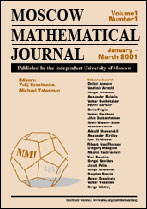|
This article is cited in 60 scientific papers (total in 60 papers)
Variational principles for Lie–Poisson and Hamilton–Poincaré equations
H. Sendraa, J. E. Marsdenb, S. Pekarskiic, T. S. Ratiud
a Departamento de Matematica, Universidad Nacional del Sur
b California Institute of Technology
c Moody's Investors Service
d Ecole Polytechnique Fédérale de Lausanne
Abstract:
As is well-known, there is a variational principle for the Euler–Poincaré; equations on a Lie algebra $\mathfrak g$ of a Lie group $G$ obtained by reducing Hamilton's principle on $G$ by the action of $G$ by, say, left multiplication. The purpose of this paper is to give a variational principle for the Lie–Poisson equations on $\mathfrak g^*$, the dual of $\mathfrak g$, and also to generalize this construction.
The more general situation is that in which the original configuration space is not a Lie group, but rather a configuration manifold $Q$ on which a Lie group $G$ acts freely and properly, so that $Q\to Q/G$ becomes a principal bundle. Starting with a Lagrangian system on $TQ$ invariant under the tangent lifted action of $G$, the reduced equations on $(TQ)/G$, appropriately identified, are the Lagrange–Poincaré equations. Similarly, if we start with a Hamiltonian system on $T^*Q$, invariant under the cotangent lifted action of $G$, the resulting reduced equations on $T^*Q)/G$ are called the Hamilton–Poincaré equations.
Amongst our new results, we derive a variational structure for the Hamilton–Poincaré equations, give a formula for the Poisson structure on these reduced spaces that simplifies previous formulas of Montgomery, and give a new representation for the symplectic structure on the associated symplectic leaves. We illustrate the formalism with a simple, but interesting example, that of a rigid body with internal rotors.
Key words and phrases:
Geometric mechanics, Euler–Lagrange, Lagrangian reduction, Euler–Poincaré, Lagrange–Poincaré, Hamilton–Poincaré.
Received: December 24, 2002; in revised form July 24, 2003
Citation:
H. Sendra, J. E. Marsden, S. Pekarskii, T. S. Ratiu, “Variational principles for Lie–Poisson and Hamilton–Poincaré equations”, Mosc. Math. J., 3:3 (2003), 833–867
Linking options:
https://www.mathnet.ru/eng/mmj111 https://www.mathnet.ru/eng/mmj/v3/i3/p833
|

| Statistics & downloads: |
| Abstract page: | 621 | | References: | 97 |
|




 Contact us:
Contact us: Terms of Use
Terms of Use
 Registration to the website
Registration to the website Logotypes
Logotypes








 Citation in format
Citation in format 
